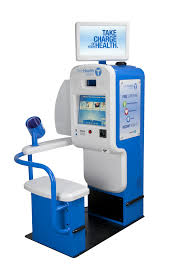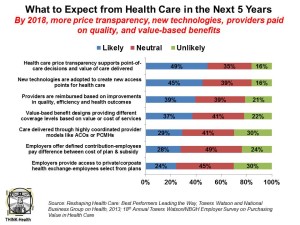Employers who provide health insurance are getting much more aggressive in 2013 and beyond in terms of increasing employees’ responsibilities for staying well and taking our meds, shopping for services based on cost and value, and paying doctors based on their success with patients’ health outcomes and quality of care. Furthermore, nearly one-half expect that technologies like telemedicine, mobile health apps, and health kiosks in the back of grocery stores and pharmacies are expected to change the way people regularly receive health care.
What’s behind this? Increasing health care costs, to be sure, explains the 18th annual survey from the National Business Group on Health and Towers Watson. While most employers still plan to sponsor health benefits over the next five years, the outlook gets cloudy in companies’ ten-year crystal ball.
The chart illustrates some things to expect in the health care marketplace over the next 5 years. The most likely change in the health care scene will be the growth of price transparency, where consumers will be able — and expected to — access online information sources comparing health providers’ services, quality metrics and prices for procedures, visits, and pills. Examples of this include Castlight Health, which recently announced an alliance with WellPoint, the health plan, to provide so-called Reference Based Benefits which will enable consumers to shop for health services based on a reference (comparison) price; Red Brick and Clear Cost Health, working together to develop a health price transparency tool incorporating social networks and gaming; and, the Federal government’s Hospital Compare website, which continues to be updated with more information on local hospital prices.
The second new feature to expect from the health system over the next few years is fast-adoption of new technologies to deliver health care outside of the doctor’s office, such as telehealth/telemedicine, Skype-type visits over the Internet with physicians and therapists, and interactive health kiosks in retail stores. Think of these as bringing more self-service to health care.
A third new aspect for health care is health plans paying for quality and value. This means that doctors and hospitals will have to deliver on good outcomes; the right treatment in the right place (inpatient, outpatient, ambulatory, doctor’s office, retail clinic or via Internet) at the right time; and, managing chronic health conditions to maximize a patient’s productivity (like returning to work successfully managing the condition), avoiding hospital admissions and re-admissions, and “frequent flier” visits to the emergency room for avoidable medical mishaps.
In the next year (2013-2014), companies will focus their health care strategies on the following tactics:
- 55% will focus on staying up to date and complying with health reform (ObamaCare, the Affordable Care Act)
- 36% will educate employees to be more informed consumers of health care (e.g., driving greater price transparency, quality care information, treatment decision support)
- 34% will develop a workplace culture promoting health and wellbeing
- 25% will adopt/expand use of financial incentives to encourage healthy behaviors (e.g., like lowering BMI and quitting smoking)
22% will expand healthy lifestyle activities - 20% will review health benefits as part of total compensation.
Wellness programs will be especially targeted to smoking cessation (among one-third of employers), and implementing a serious “stick” to employees who smoke: 42% of companies will use a “surcharge” for tobacco users at about $50 a month — resulting in a kind of smoking tax on employees who smoke.
On the other hand, more companies will adopt “carrots” — incentives — to promote healthier living. More than two-thirds of companies offer financial incentives to employees who participate in wellness programs, which will rise to 81% of employers doing so in 2014.
Health Populi’s Hot Points: People who receive health benefits from work should pay attention to these major changes in the health market which will force us to adapt to new ways of receiving and paying for health care:
- Find trustworthy, easy-to-understand sources of health care price and quality information
 Learn to shop based on quality and price of health services
Learn to shop based on quality and price of health services- Ask friends, family and other people in your social network who may be managing a health condition you’re managing for referrals to providers they trust
- Take advantage of wellness programs at work: these can be worth hard dollars to you, as well as premium discounts where employers use that tactic to keep employees working on health and wellness
- Quit smoking ASAP: it’s good for your health, your family’s and friends’ health, as well as your personal finances
- Be open to receiving care outside of the doctor’s office: try out the new health kiosk at Walmart, Target, the pharmacy, or your grocery store: it’s the new, cool blood pressure cuff! Here’s an example of one found at Walmart called SoloHealth.
For more on price transparency, read a summary on the recent Congressional testimony to the Senate Finance Committee from June 18, 2013 here.
For more on health care everywhere, see: Primary Care, Everywhere, from California HealthCare Foundation.
For more on mental health services, such as counseling and therapy, via Skype-type technologies, see: The Online Couch: Mental Healthcare on the Web, from California HealthCare Foundation.





 Thank you FeedSpot for
Thank you FeedSpot for